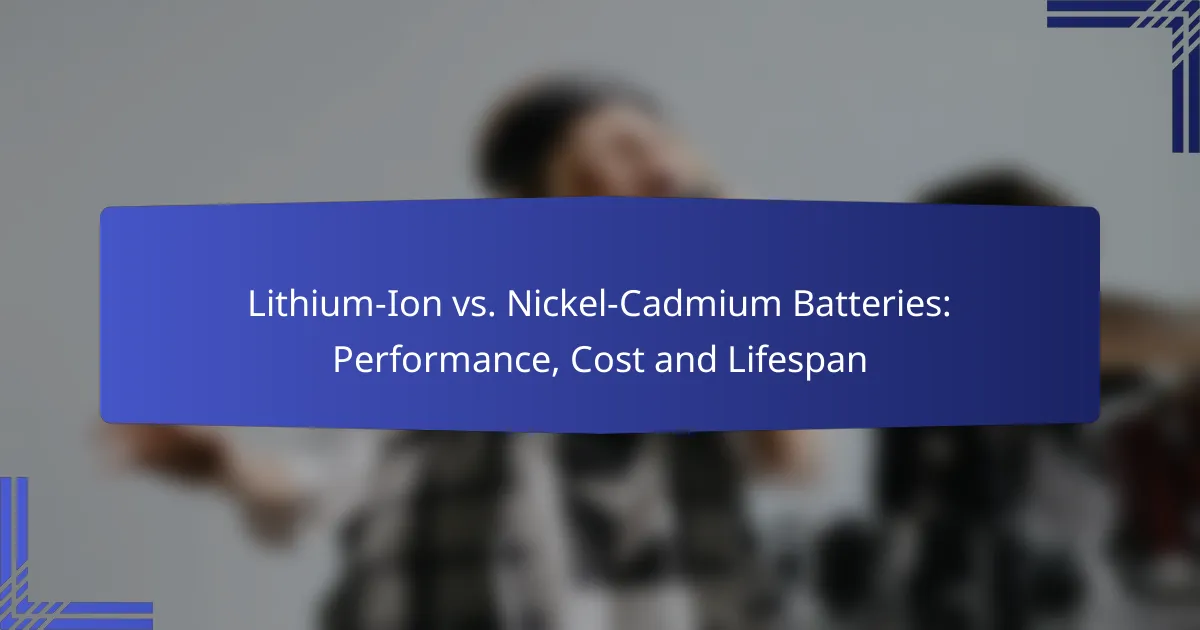When comparing Lithium-Ion and Nickel-Cadmium batteries, Lithium-Ion emerges as the superior choice for performance, longevity, and efficiency. Although they come with a higher initial cost, their extended lifespan and enhanced capabilities often result in lower total expenses over time. This makes Lithium-Ion batteries particularly advantageous for applications requiring reliable and sustained power supply.
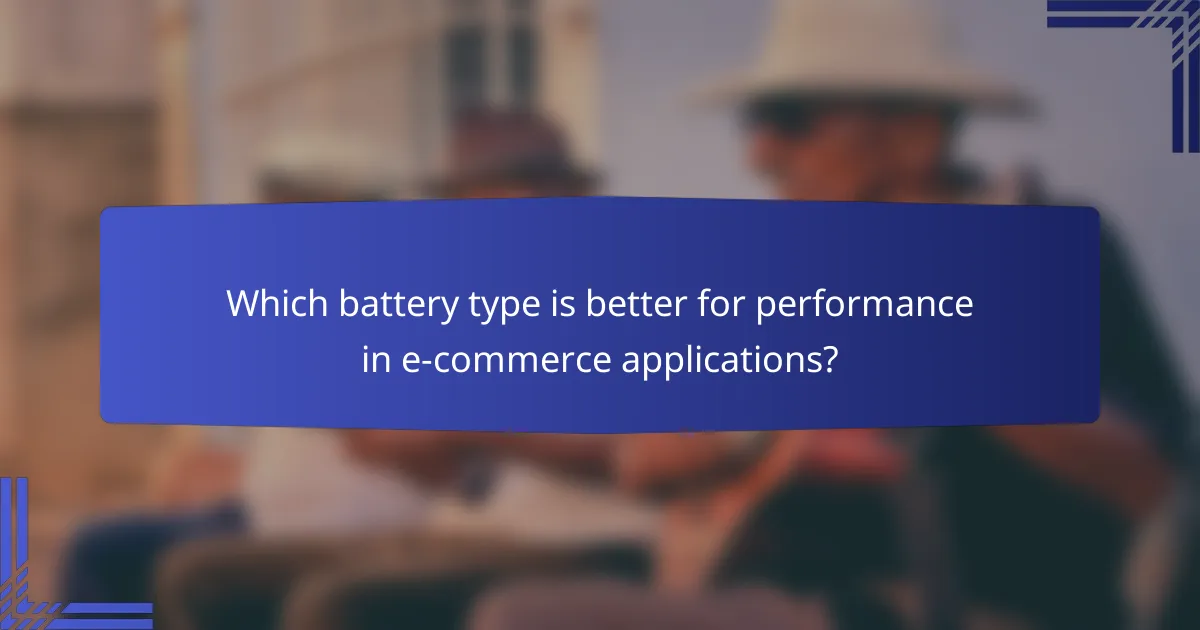
Which battery type is better for performance in e-commerce applications?
Lithium-Ion batteries generally outperform Nickel-Cadmium batteries in e-commerce applications due to their higher energy density, longer lifespan, and faster charging capabilities. These factors make Lithium-Ion a preferred choice for devices requiring efficient and reliable power supply.
Lithium-Ion battery advantages
Lithium-Ion batteries offer several advantages, including a higher energy density, which allows them to store more energy in a smaller size. This is particularly beneficial for portable devices used in e-commerce, where space and weight are critical.
Additionally, Lithium-Ion batteries have a longer lifespan, often lasting several years with proper care. They also charge faster than Nickel-Cadmium batteries, making them ideal for applications where downtime needs to be minimized.
Nickel-Cadmium battery advantages
Nickel-Cadmium batteries are known for their robustness and ability to perform well in extreme temperatures. They can handle deep discharges without significant damage, which can be advantageous in specific e-commerce scenarios where power reliability is crucial.
Another benefit is their lower initial cost compared to Lithium-Ion batteries. This can make Nickel-Cadmium a more budget-friendly option for businesses just starting or those with less intensive power needs.
Performance comparison metrics
When comparing Lithium-Ion and Nickel-Cadmium batteries, key performance metrics include energy density, charge time, cycle life, and temperature tolerance. Lithium-Ion batteries typically have an energy density of around 150-250 Wh/kg, while Nickel-Cadmium batteries range from 40-60 Wh/kg.
In terms of charge time, Lithium-Ion batteries can often reach full charge in 1-3 hours, whereas Nickel-Cadmium batteries may take longer. Cycle life is another critical metric, with Lithium-Ion batteries lasting around 500-1500 cycles compared to 1000 cycles for Nickel-Cadmium batteries.
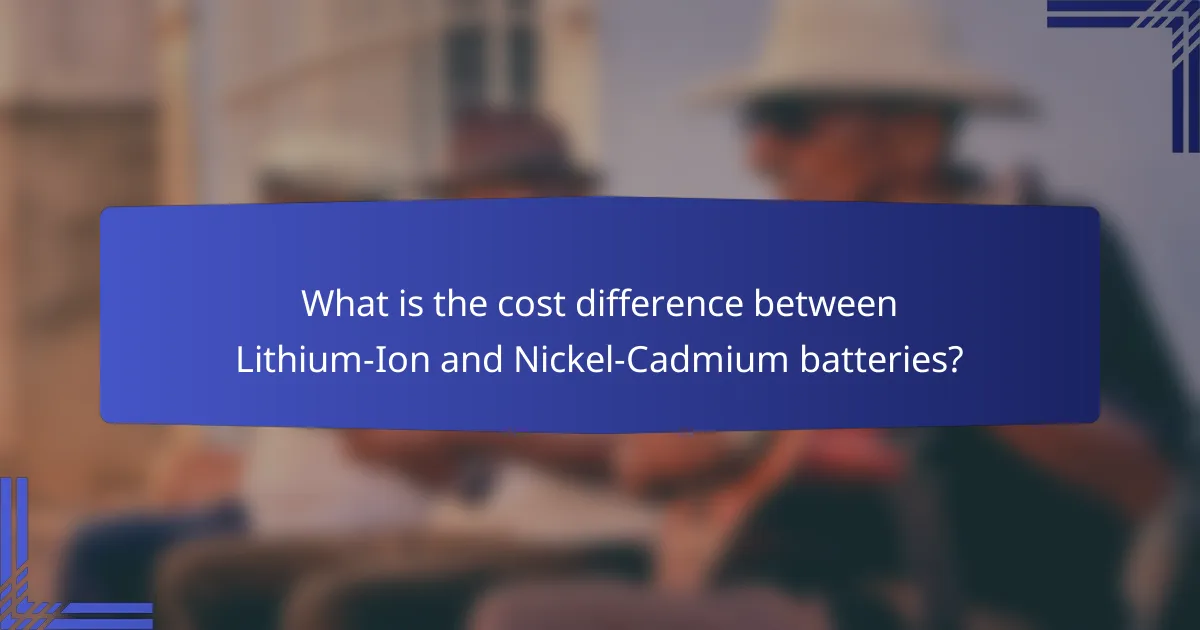
What is the cost difference between Lithium-Ion and Nickel-Cadmium batteries?
The cost difference between Lithium-Ion and Nickel-Cadmium batteries is significant, with Lithium-Ion batteries generally being more expensive upfront. However, their longer lifespan and better performance can lead to lower overall costs in the long run.
Lithium-Ion battery pricing
Lithium-Ion batteries typically range from around $100 to $300 per kilowatt-hour (kWh) depending on the specific type and application. Prices have been decreasing steadily due to advancements in technology and increased production capacity. For consumer electronics, such as smartphones and laptops, the cost can vary based on brand and specifications.
Nickel-Cadmium battery pricing
Nickel-Cadmium batteries are generally less expensive, with prices ranging from $50 to $150 per kWh. They are often used in applications where cost is a primary concern, such as in power tools and emergency lighting systems. However, their higher self-discharge rates and environmental regulations can affect long-term costs.
Cost-effectiveness analysis
When comparing cost-effectiveness, consider both initial purchase price and total lifecycle costs. While Lithium-Ion batteries have a higher upfront cost, their longer lifespan—often exceeding 10 years—can result in lower replacement and maintenance costs. In contrast, Nickel-Cadmium batteries may require more frequent replacements, which can add up over time.
Additionally, Lithium-Ion batteries offer better energy density and efficiency, making them more suitable for applications requiring longer run times. Evaluating the specific needs of your application will help determine which battery type provides the best value for your investment.

How does the lifespan of Lithium-Ion batteries compare to Nickel-Cadmium?
Lithium-Ion batteries generally have a longer lifespan compared to Nickel-Cadmium batteries, often lasting several years longer under similar usage conditions. While Lithium-Ion can typically endure hundreds to over a thousand charge cycles, Nickel-Cadmium batteries usually last for a few hundred cycles before performance declines significantly.
Lithium-Ion lifespan statistics
Lithium-Ion batteries can last anywhere from 2 to 10 years, depending on usage and care. They typically offer around 500 to 1,500 charge cycles, with a cycle defined as a full discharge and recharge. Factors such as temperature, charging habits, and depth of discharge can significantly influence their longevity.
For example, keeping a Lithium-Ion battery at moderate temperatures and avoiding complete discharges can help maximize its lifespan. Many manufacturers recommend maintaining a charge level between 20% and 80% for optimal performance.
Nickel-Cadmium lifespan statistics
Nickel-Cadmium batteries usually have a lifespan of about 2 to 5 years, with around 500 to 800 charge cycles. Their performance can degrade more rapidly if they are not fully discharged regularly, a practice known as “cycling.” This is important as it helps prevent the memory effect, which can reduce the effective capacity of the battery.
Despite their shorter lifespan, Nickel-Cadmium batteries can tolerate extreme temperatures better than Lithium-Ion batteries, making them suitable for specific applications where temperature fluctuations are common.
Factors affecting battery lifespan
Several factors influence the lifespan of both Lithium-Ion and Nickel-Cadmium batteries. Temperature is a critical factor; extreme heat can shorten the lifespan of Lithium-Ion batteries, while cold conditions can negatively impact Nickel-Cadmium performance. Additionally, charging practices play a significant role; frequent overcharging or deep discharging can lead to premature failure.
Another factor is the quality of the battery itself; higher-quality batteries often have better longevity. Regular maintenance, such as cleaning terminals and ensuring proper storage, can also extend the life of both types of batteries. Users should be mindful of their specific usage patterns to optimize battery performance.

What are the environmental impacts of Lithium-Ion and Nickel-Cadmium batteries?
The environmental impacts of Lithium-Ion and Nickel-Cadmium batteries vary significantly, primarily due to their chemical compositions and disposal methods. Lithium-Ion batteries generally have a lower toxic profile but pose recycling challenges, while Nickel-Cadmium batteries contain hazardous materials that require careful handling and disposal.
Recycling processes for Lithium-Ion batteries
Recycling Lithium-Ion batteries involves several key steps to recover valuable materials like lithium, cobalt, and nickel. The process typically starts with collection and transportation to specialized recycling facilities where batteries are disassembled and sorted. Techniques such as pyrometallurgical and hydrometallurgical processes are employed to extract metals from the battery components.
Many countries have established regulations to promote the recycling of Lithium-Ion batteries, encouraging manufacturers to implement take-back programs. Consumers can often find local recycling points or participate in manufacturer-sponsored events to ensure proper disposal.
Recycling processes for Nickel-Cadmium batteries
Nickel-Cadmium batteries are recycled through a process that safely handles their toxic cadmium content. The recycling process begins with the collection of used batteries, which are then transported to facilities equipped to manage hazardous waste. Here, the batteries are mechanically processed to separate the nickel and cadmium from other materials.
Due to the hazardous nature of cadmium, strict regulations govern the recycling of Nickel-Cadmium batteries in many regions. Consumers should look for certified recycling programs to ensure that these batteries are disposed of safely and responsibly, minimizing environmental risks.
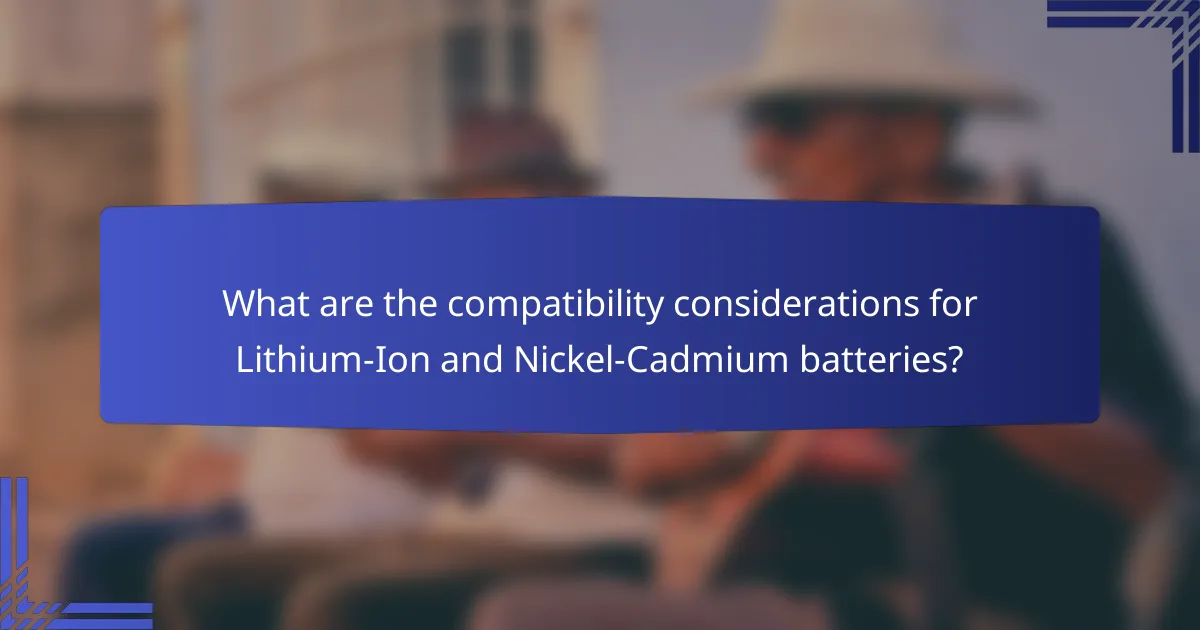
What are the compatibility considerations for Lithium-Ion and Nickel-Cadmium batteries?
Compatibility for Lithium-Ion and Nickel-Cadmium batteries primarily hinges on the device’s design and charging requirements. Each battery type has distinct voltage levels and charging protocols, making it crucial to match the battery with the appropriate device to ensure optimal performance and safety.
Device compatibility for Lithium-Ion
Lithium-Ion batteries are widely used in modern electronics, including smartphones, laptops, and electric vehicles. These devices typically require specific voltage levels, often around 3.7 volts per cell, and advanced charging circuits that manage the charging process to prevent overheating and overcharging.
When selecting a Lithium-Ion battery, ensure that the device’s specifications match the battery’s voltage and capacity ratings. Using an incompatible battery can lead to reduced performance or even damage to the device.
Device compatibility for Nickel-Cadmium
Nickel-Cadmium batteries are less common in contemporary devices but are still found in some power tools and older electronics. They usually operate at a nominal voltage of 1.2 volts per cell and may require specific chargers designed for their chemistry to avoid issues like memory effect.
Compatibility considerations for Nickel-Cadmium batteries include ensuring that the device can handle their lower voltage and that it has the appropriate charging mechanism. Using a Nickel-Cadmium battery in a device designed for Lithium-Ion can result in inadequate performance and potential safety hazards.
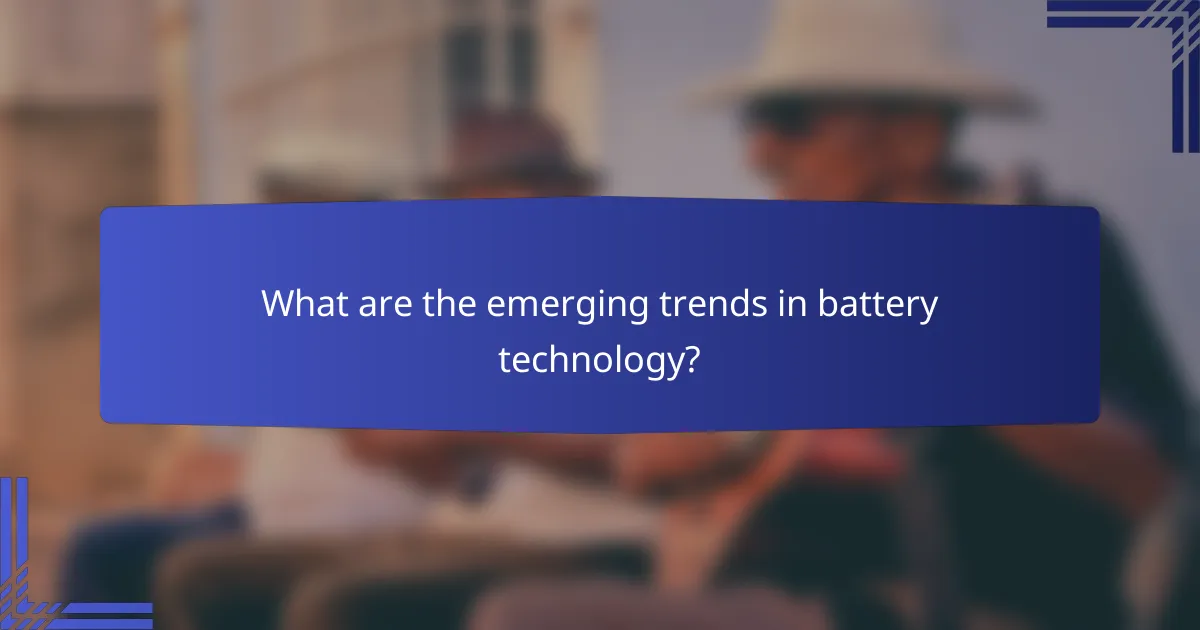
What are the emerging trends in battery technology?
Emerging trends in battery technology focus on improving energy density, reducing costs, and enhancing sustainability. Innovations in materials and manufacturing processes are driving advancements, particularly in lithium-ion and alternative battery chemistries.
Advancements in Lithium-Ion technology
Recent advancements in lithium-ion technology include the development of solid-state batteries, which promise higher energy densities and improved safety compared to traditional liquid electrolyte designs. These batteries can potentially reduce the risk of leaks and fires, making them a safer option for consumer electronics and electric vehicles.
Another significant trend is the use of silicon anodes instead of conventional graphite. Silicon can store more lithium ions, leading to batteries with greater capacity and longer lifespans. This shift could enhance the performance of devices that rely heavily on battery power, such as smartphones and electric cars.
Furthermore, recycling processes for lithium-ion batteries are being refined to recover valuable materials and reduce environmental impact. Companies are investing in technologies that can efficiently reclaim lithium, cobalt, and nickel, which helps lower production costs and supports a circular economy in battery manufacturing.
